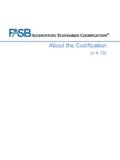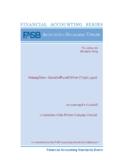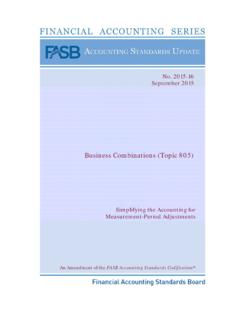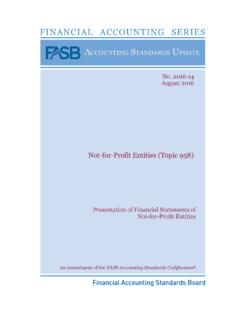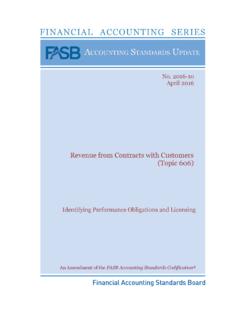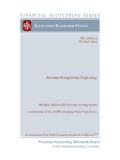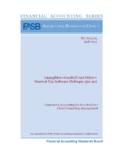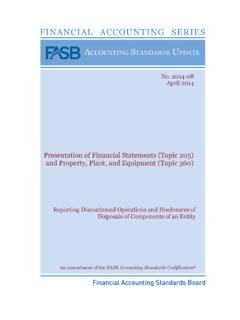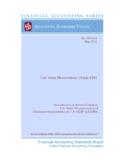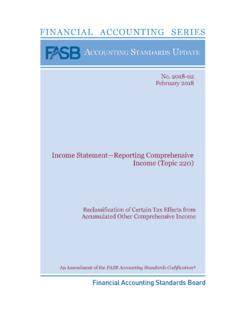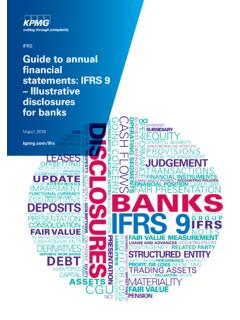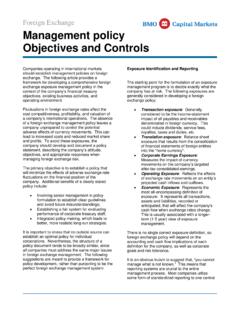Transcription of Derivatives and Hedging (Topic 815) - FASB
1 Derivatives and Hedging ( topic 815 ) No. 2017-12 August 2017 Targeted Improvements to accounting forHedging Activities An Amendment of the FASB accounting Standards Codification The FASB accounting Standards Codification is the source of authoritative generally accepted accounting principles (GAAP) recognized by the FASB to be applied by nongovernmental entities. An accounting Standards Update is not authoritative; rather, it is a document that communicates how the accounting Standards Codification is being amended. It also provides other information to help a user of GAAP understand how and why GAAP is changing and when the changes will be effective. For additional copies of this accounting Standards Update and information on applicable prices and discount rates contact: Order Department Financial accounting Standards Board 401 Merritt 7 PO Box 5116 Norwalk, CT 06856-5116 Please ask for our Product Code No.
2 ASU2017-12. FINANCIAL accounting SERIES (ISSN 0885-9051) is published monthly with the exception of May, July, and November by the Financial accounting Foundation, 401 Merritt 7, PO Box 5116, Norwalk, CT 06856-5116. Periodicals postage paid at Norwalk, CT and at additional mailing offices. The full subscription rate is $255 per year. POSTMASTER: Send address changes to Financial accounting Series, 401 Merritt 7, PO Box 5116, Norwalk, CT 06856-5116. | No. 456 Copyright 2017 by Financial accounting Foundation. All rights reserved. Content copyrighted by Financial accounting Foundation may not be reproduced, stored in a retrieval system, or transmitted, in any form or by any means, electronic, mechanical, photocopying, recording, or otherwise, without the prior written permission of the Financial accounting Foundation.
3 Financial accounting Foundation claims no copyright in any portion hereof that constitutes a work of the United States Government. An Amendment of the FASB accounting Standards Codification No. 2017-12 August 2017 Derivatives and Hedging ( topic 815 ) Targeted Improvements to accounting for Hedging Activities accounting Standards Update Financial accounting Standards Board accounting Standards Update 2017-12 Derivatives and Hedging ( topic 815 ) Targeted Improvements to accounting for Hedging Activities August 2017 CONTENTS Page Numbers Summary .. 1 8 Amendments to the FASB accounting Standards Codification .. 9 330 Background Information and Basis for Conclusions .. 331 398 Amendments to the XBRL Taxonomy.
4 399 1 Summary Why Is the FASB Issuing This accounting Standards Update (Update)? Stakeholders indicated that the hedge accounting requirements in current generally accepted accounting principles (GAAP) sometimes do not permit an entity to properly recognize the economic results of its Hedging strategies in its financial statements. Those stakeholders maintained that improvements to the hedge accounting model are needed to facilitate financial reporting that more closely reflects an entity s risk management activities. In addition, stakeholders note that the effect of hedge accounting on an entity s reported results often is difficult to understand and interpret.
5 They emphasize that reported results should help financial statement users to better understand an entity s risk exposures and how Hedging strategies are used to manage those exposures. To address stakeholders concerns, the Board has issued this Update with the objective of improving the financial reporting of Hedging relationships to better portray the economic results of an entity s risk management activities in its financial statements. In addition to that main objective, the amendments in this Update make certain targeted improvements to simplify the application of the hedge accounting guidance in current GAAP based on the feedback received from preparers, auditors, users, and other stakeholders.
6 Who Is Affected by the Amendments in This Update? The amendments in this Update apply to any entity that elects to apply hedge accounting in accordance with current GAAP. What Are the Main Provisions and How Do They Differ from Current Generally Accepted accounting Principles (GAAP)? Alignment of Risk Management Activities and Financial Reporting The amendments in this Update better align an entity s risk management activities and financial reporting for Hedging relationships through changes to both the designation and measurement guidance for qualifying Hedging relationships and the presentation of hedge results. To meet that objective, the amendments expand and refine hedge accounting for both nonfinancial and financial risk components 2 and align the recognition and presentation of the effects of the Hedging instrument and the hedged item in the financial statements.
7 Risk Component Hedging Current GAAP contains limitations on how an entity can designate the hedged risk in certain cash flow and fair value Hedging relationships. To address those current limitations, the amendments in this Update permit hedge accounting for risk components in Hedging relationships involving nonfinancial risk and interest rate risk as follows: 1. For a cash flow hedge of a forecasted purchase or sale of a nonfinancial asset, an entity could designate as the hedged risk the variability in cash flows attributable to changes in a contractually specified component stated in the contract. The amendments remove the requirement in current GAAP that only the overall variability in cash flows or variability related to foreign currency risk could be designated as the hedged risk in a cash flow hedge of a nonfinancial asset.
8 2. For a cash flow hedge of interest rate risk of a variable-rate financial instrument, an entity could designate as the hedged risk the variability in cash flows attributable to the contractually specified interest rate. By eliminating the concept of benchmark interest rates for hedges of variable-rate instruments in current GAAP, the amendments remove the requirement to designate only the overall variability in cash flows as the hedged risk in a cash flow hedge of a variable-rate instrument indexed to a nonbenchmark interest rate. 3. For a fair value hedge of interest rate risk, the amendments add the Securities Industry and Financial Markets Association (SIFMA) Municipal Swap Rate as an eligible benchmark interest rate in the United States in addition to those already permitted under current GAAP (the Treasury Rate, the London Interbank Offered Rate [LIBOR] Swap Rate, and the Fed Funds Effective Swap Rate [or Overnight Index Swap Rate]).
9 This allows an entity that issues or invests in fixed-rate tax-exempt financial instruments to designate as the hedged risk changes in fair value attributable to interest rate risk related to the SIFMA Municipal Swap Rate rather than overall changes in fair value. accounting for the Hedged Item in Fair Value Hedges of Interest Rate Risk In some cases, current GAAP contains limitations on how an entity can designate the hedged item in a fair value hedge of interest rate risk. In other cases, current GAAP contains limitations on how an entity can measure changes in fair value of the hedged item attributable to interest rate risk in certain fair value Hedging relationships. Those limitations may not align with an entity s risk management 3 strategies or the way in which interest rate risk can be hedged in the cash flow Hedging model.
10 To resolve those issues, the amendments in this Update change the guidance for designating fair value hedges of interest rate risk and for measuring the change in fair value of the hedged item in fair value hedges of interest rate risk. Specifically, the amendments: 1. Permit an entity to measure the change in fair value of the hedged item on the basis of the benchmark rate component of the contractual coupon cash flows determined at hedge inception, rather than on the full contractual coupon cash flows as required by current GAAP. 2. Permit an entity to measure the hedged item in a partial-term fair value hedge of interest rate risk by assuming the hedged item has a term that reflects only the designated cash flows being hedged.
